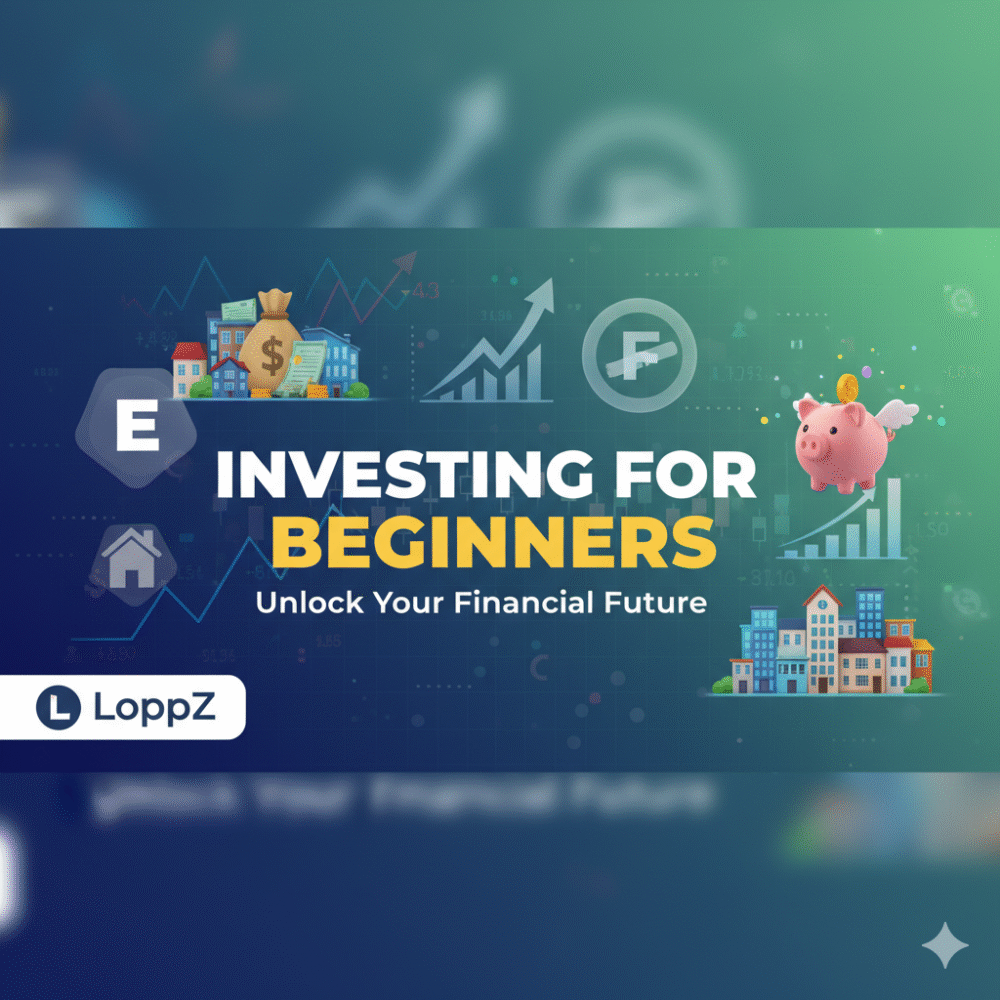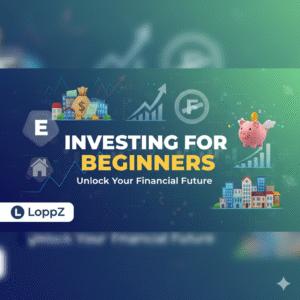Introduction: Debunking the Biggest Myth
Beginner Investment Guide in 2025: Learn to invest in stocks, bonds & ETFs. Start your wealth journey today with LoppZ.
The widespread belief that investing is just for the wealthy is probably one of the most damaging misconceptions holding back potential investors. This gap between those who understood investing and everyone else seemed almost insurmountable before, but that’s no longer the case.
Companies and services today have made it their mission to level the playing field by expanding access to investment opportunities for newcomers and people with modest budgets.
- There’s no reason to hold off any longer, as there are plenty of entry-level investment options, but we’ll cover just a couple in this post.
With all the free investing knowledge and tools available today, now has never been a better time to become financially independent. So, let’s talk about investing concepts for beginners.
One thing you should keep in mind: don’t expect to learn everything you need to know by reading a few articles. Investing is a big field, and there’s a lot to learn.
The greatest, most successful investors are always learning and polishing their financial market talents.
- So, let’s dive in a little deeper into some of the basics. Nearly all investments fall into one or more “asset classes”.
Understanding Asset Classes
An asset class consists of investments with comparable characteristics and rules. Historically speaking there are 3 main asset classes: Equities (like stocks), Fixed Income (like bonds), and cash-equivalents (like Money market accounts).
Today though, most financial professionals will also consider: Commodities (like oil and gold futures), real estate, and currencies as additional asset classes. Now, asset classes may be considered more or less “liquid”.
This term determines how easy or hard it is to exchange the asset for cash. Stocks are a liquid asset. You can just log into your brokerage account and sell the stock today, but real estate is a little more illiquid.
- You’d have to wait to sell the house before you could get your cash. Let’s take a deeper dive into our first asset class:
Equities (Stocks)
Equity investing, the purchasing and selling of publicly traded company stocks or funds, is one of the best beginner investments. Publicly traded corporations provide investors stock shares for an equity stake.
When that company’s share price rises, shareholders profit from those price increases. When it comes to the price of stocks, the company’s performance is typically the biggest factor on whether it will go up or down.
For instance, currently in 2022, Netflix has missed its financial estimates for several quarters and the market has seen its price share drop almost 65%! Other influences on share price are industry performance, competitor performance, economic conditions, and government activities.
- Aside from share price, investors can also earn additional income through dividends. You can think of dividends like interest on stocks or a per-share bonus.
To learn which companies are paying dividends, you can use a site like Dividend.com which lets you study and compare dividend-paying stocks. So where does all this buying and selling happen? There are organizations that govern and manage stock trading, called exchanges, examples of large exchanges are the United States’ New York Stock Exchange, the UK’s London Stock Exchange, and Japan’s Tokyo Exchange.
Fixed Income (Bonds)
Investing always entails risk, and as an investor, you must learn your risk tolerance, how much or little risk you can handle. Generally speaking, the higher the risk the higher the reward, but some investors do not like the risk of equities, and may opt for a lower risk asset class.
This is where fixed-income investing comes in. Fixed income investing refers to investments in debt securities that offer fixed-rate interest payments over a predetermined time frame.
Bonds are an example of debt securities. The bond market is one of the world’s largest due to the massive amounts of government debt. When you buy a bond, you finance a business or government and receive an interest rate known as a “coupon rate” in exchange.
Bonds pay interest semi-annually or annually until the bond’s maturity date. The coupon rate is the yield from the interest at the time it’s issued (the time at which you buy it).
Bonds have an inverse relationship to interest rates. This is because Bonds tend to pay out a fixed interest rate, so when the cost of borrowing money is more expensive, (when interest rates rise), bond prices tend to fall because consumers will like the higher interest rate of the market.
Fixed-income assets are popular for their minimal risk. If you buy these I.O.U.’s from a developed and reliable country like the United States, your return on investment is almost a certainty.
Real Estate Investing
The real estate asset class is technically defined by “real property” which simply means land and any infrastructure improvements put upon it, like a building, trees, etc.
The three most common real estate properties are residential, commercial, and land. Investing in real estate offers leverage, meaning you can use a smaller amount of your own money to control a larger investment.
Leverage lets you make a lot with a little. But if you’re not careful it can burn you. Leverage can amplify returns, but it can also amplify losses.
So, it’s unwise to use leverage until you’re more advanced as a trader or investor. Leveraged investing requires careful money management. With leveraged investments, you can actually lose more than your total investment, unlike with stocks or bonds.
There are few better ways to lose all your money, than treating leverage like a roll of the dice. Remember, you as the investor, have to determine your risk tolerance.
How Do You Actually Start Investing?
So, we’ve discussed a few of the basic asset classes. These will be the ones that newer investors will most likely first start investing into, but how do you actually invest in them? Typically, to invest into stocks and bonds, you’ll need access to a brokerage account.
Vanguard, Fidelity, and Robinhood are just a few examples of brokerage account holders. They are the companies through which you can then purchase stocks and bonds.
When you open a brokerage account, you’ll have access to the stocks and bonds on the exchange available through that broker. From there, you would connect your bank account and then set up a deposit from your bank into the brokerage.
Once there was money in your brokerage account, you would then pick the stock, bond, mutual fund, or ETF you wanted to invest in and purchase shares.
In the past, you’d need the full amount of a share, but today, with fractional shares, you can invest as much or as little as you’d like.
For example, Apple stock is around $150. You could put $300 dollars in and purchase 2 full shares, or you can decide you only have $50 that you can invest and purchase what would be 1/3 of a share.
- This now becomes an income producing asset for the investor.
Conclusion: It’s Never Too Late to Start
We know investing is a big subject, and the topic generates a lot of different opinions about the best way to go about it. So much so that it can seem very overwhelming for beginners.
Sadly, most people never begin to seriously consider investing until they’re well into their income earning years. Our educational system lacks even fundamental financial and investing education.
Be thankful if you’re younger and reading this, but don’t be discouraged if you’re older. It’s never too late to start investing, and the sooner you start, the sooner you’ll go beyond investing for beginners and reach your financial goals.









